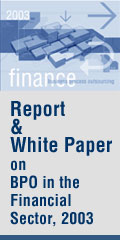|
|
Higher provisioning stipulation by RBI in the policy review to impact banks’ profitability- Crisil
October 28, 2009:
The Reserve Bank of India (RBI) has, in its review of the monetary policy, stipulated that banks
maintain a minimum provisioning coverage of 70 per cent on their non-performing assets (NPAs) by
end-September 2010. This is one of the key measures introduced by RBI to strengthen India’s banking
sector over the long term. CRISIL believes that the measure will enhance the resilience of the banking
system to absorb loan losses; however, the measure will also lead to a decline in the sector’s
profitability over the near term. The measure should also increase the consistency in banks’
provisioning for NPAs and facilitate a more meaningful comparison of their profits.
CRISIL estimates that the proposed minimum coverage for NPAs will mean that banks now have to
make an additional provisioning of Rs.130 billion till end-September 2010. CRISIL’s estimate is
based on the NPAs reported by banks as on March 31, 2009: the NPAs were at 2.3 per cent of system
advances, while the NPA coverage was around 55 per cent as on that date.
CRISIL believes that the banking system’s NPAs will increase, despite significant restructuring
undertaken by banks in the past six months. Due to extensive restructuring, banks’ NPAs are unlikely to increase to
the extent that CRISIL had previously expected them to. However, even if NPAs rise to 3 per cent by
March 2010, as against CRISIL’s previous estimate of 3.9 per cent, the required additional
provisioning will increase by Rs.200 billion. Therefore, the total provisioning requirement for the
system will be Rs.300 billion to Rs.330 billion till end-September 2010.
Says Mr. Raman Uberoi, Senior Director, CRISIL Ratings, “The expected increase in
provisioning will exacerbate the profitability pressures that India’s banks have been facing on
account of pressure on fee income.” The additional provisioning will be 20 to 25 per cent of the
sector’s expected profits for 2009-10 (refers to financial year, April 1 to March 31) and 2010-11, as
the impact will be spread over two years.
>> GO TO NEXT PAGE
RBI 2nd QUARTER REVIEW OF MONETARY POLICY 2009-10..
read full text
Credit quality stabilising, but recovery will be slow
Indian Banks are generally resilient under stress test
Federal Bank on watch on possible merger with Catholic Syrian Bank
Moody's places ratings of 13 banks on review
S&P revises outlook on 12 Indian banks to negative
S&P cuts India outlook to negative on unsustainable deficit
Fitch Affirms India’s Long-term foreign currency & local currency ratings
Moody's changes credit outlook for Indian banking to negative
Fitch affirms Indian Bank's ratings with long term stable outlook
India's Ratings Maintained by S&P on Growth Outlook
Tough year ahead for Asian banks as recession spreads
Outlooks on most banking systems in Asia Pacific turns negative
Greater refinancing risk for Asia-Pacific borrowers
Government measures should stabilize global banking markets
Global banking industry to see more restructuring & consolidation
Indian Banking sector challenged by domestic, not global, factors
CLICK FOR MORE FEATURES & STORIES
|
|


|


